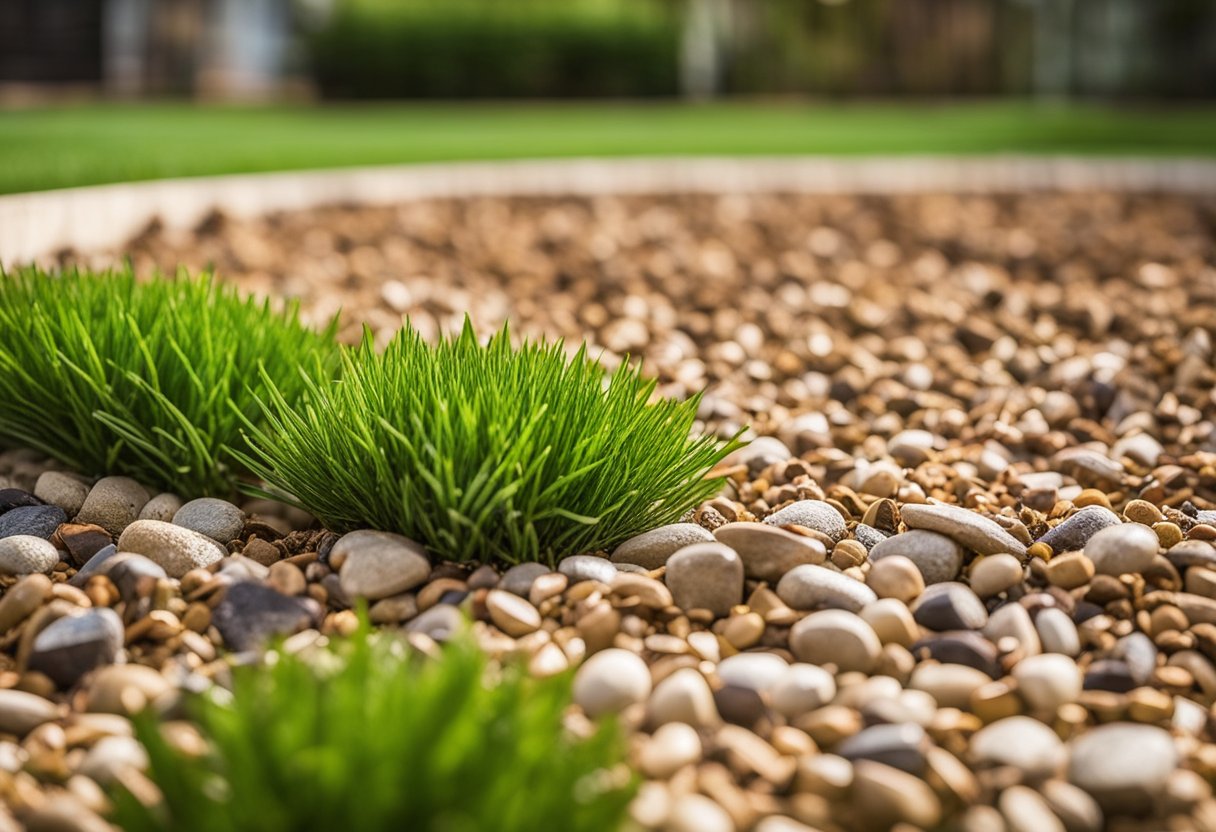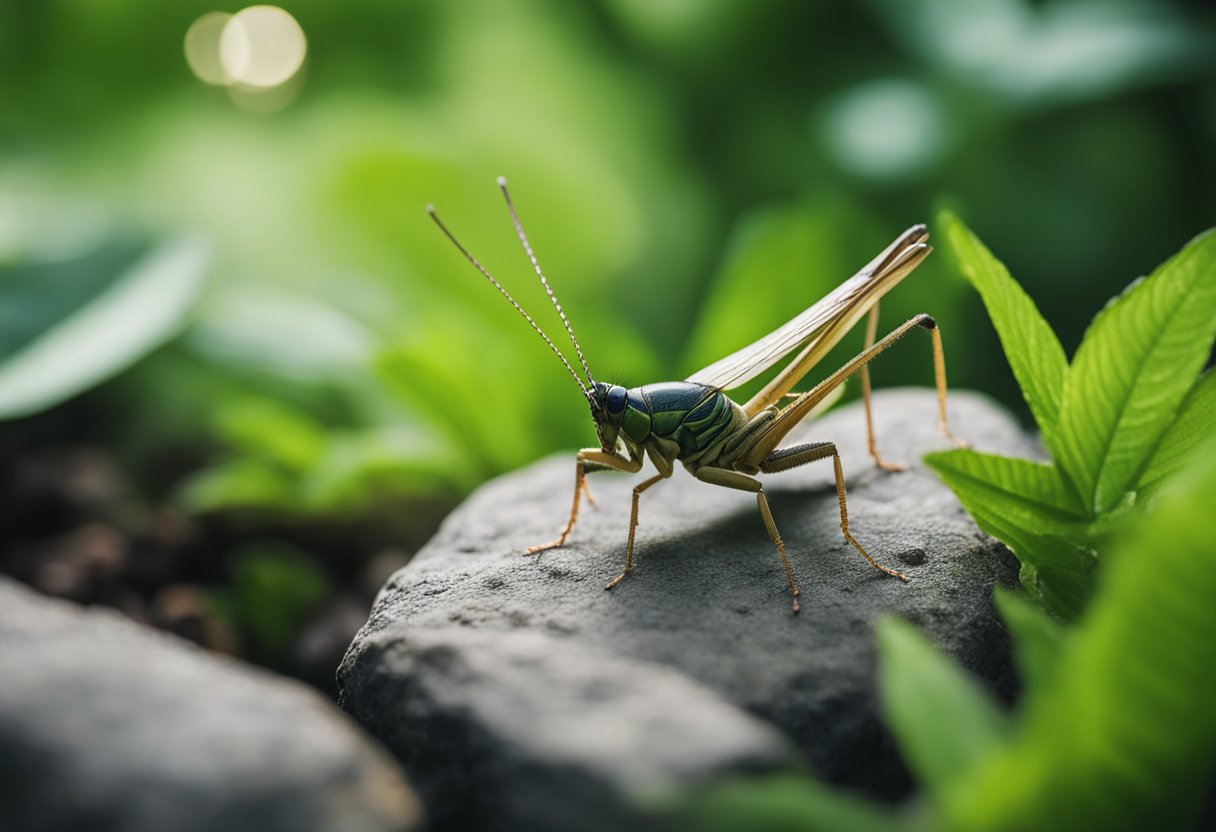Landscaping one’s garden or yard provides the opportunity not only to create an appealing outdoor space but also to implement strategies for deterring unwanted pests like crickets. These insects, known for their chirping and potential to cause damage to plants, can be managed through deliberate landscaping choices. Effective cricket control begins with understanding the cricket’s attraction to the environment and strategizing ways to make a garden less inviting to them.

Incorporating plants that are known to repel crickets is a natural and aesthetically pleasing method to reduce their presence. Certain herbs and flowers emit scents that are unattractive to crickets, which can be a key feature in a well-thought-out landscaping design. Besides olfactory deterrents, a carefully considered landscape can minimize cricket habitats by avoiding the excessive moisture and dense vegetation that crickets favor for shelter and breeding.
Adjustments in landscaping practices can contribute significantly to keeping cricket populations under control. The maintenance of a clean yard, the proper management of debris and plant matter, and the smart selection of plants are all measures that, when implemented, reduce the likelihood of cricket infestations. Through these efforts, homeowners can create outdoor spaces that thrive without the interference of these common garden pests.
Understanding Cricket Behavior

To deter crickets effectively, one must start by comprehending their species-specific behaviors and dietary preferences which directly impact their choice of habitat.
Types of Crickets and Their Habitats
Crickets thrive in a variety of environments, often chosen based on the species. Field crickets prefer outdoor environments with grassy fields, while house crickets are more adaptable, sometimes infiltrating indoor spaces in search of warmth. Common to both species is the preference for dark, moist, and sheltered areas where they can hide from predators and harsh weather conditions.
Table 1: Habitats of Common Cricket Types
| Cricket Type | Preferred Habitat | Indoors/Outdoors |
|---|---|---|
| Field Crickets | Grassy Areas, Mulch | Outdoors |
| House Crickets | Warm, Moist Areas | Both |
Feeding Habits: What Crickets Eat
Crickets are omnivorous and scavenge on a mixture of organic matter. Their diet primarily includes plants, decaying plant material, and smaller insects. This feeding behavior can lead to a cricket infestation if they find a substantial food source indoors or in garden areas. Effective landscaping to deter crickets involves minimizing their food supply by keeping areas clean and free of debris.
- Field Crickets: Feed on plants and decaying matter.
- House Crickets: Consume a wider range, including fabrics and food waste.
Understanding these behaviors is pivotal in creating a landscape that naturally repels crickets by tailoring the environment to be less attractive to them.
Preventive Measures Against Crickets

Preventive strategies are vital in deterring crickets, focusing on modifying landscaping and outdoor lighting to create an inhospitable environment for these pests.
Landscaping Tips to Maintain a Cricket-Free Yard
A well-maintained yard is less inviting to crickets. They thrive in moist environments, so it’s imperative to eliminate standing water where possible. Regularly clean gutters and ensure proper drainage away from the home’s foundation. Moisture control extends to lawn care; avoid overwatering, and allow the soil to dry between waterings. Woodpiles should be kept neat and, if possible, elevated from the ground to reduce the chances of creating a cricket habitat. Use the following landscaping tips to discourage cricket infestations:
- Trim vegetation: Keep plants well-trimmed and away from the home’s exterior. Overgrown vegetation provides shelter for crickets.
- Seal entry points: Crickets can enter homes through cracks and crevices. Seal these areas, especially around doors, windows, and foundation.
- Remove debris: Regularly remove leaf litter and debris where crickets may take cover.
Effective Use of Outdoor Lighting
Crickets are attracted to bright outdoor lights, which can inadvertently invite them closer to your home. To prevent this:
- Use yellow light bulbs or sodium vapor lights for exterior lighting. They are less attractive to crickets and other nocturnal insects.
- Place lights away from the house, using pole lights when possible, so that insects are drawn away from the building.
Natural Predators and Biological Solutions

Implementing natural predators and biological solutions in one’s garden landscape is an effective strategy for cricket deterrence. These eco-friendly methods leverage the food chain and habitat preferences to keep cricket populations in check.
Attracting Birds to Your Garden
Birds are one of the primary natural predators of crickets. To draw them to a garden, one might provide birdhouses, bird baths, and a selection of plants that produce seeds and berries. Ensuring a consistent water source is particularly important, as it not only offers hydration but also acts as a spot for birds to bathe and stay cool, which in turn encourages them to visit regularly.
- Birdhouses: Place birdhouses at varying heights to cater to different species.
- Birdbaths: Keep birdbaths clean and filled with fresh water.
- Plant Selection: Opt for native plants that bear seeds and fruits.
Beneficial Insects and Wildlife
Other than birds, beneficial insects and certain wildlife such as spiders, lizards, and even cats can help manage cricket populations. Spiders are natural predators that weave webs to capture crickets. Lizards, both indoor and outdoor varieties, hunt and feed on crickets, providing an added layer of pest control.
- Spiders: Encourage spiders by reducing the use of outdoor lighting, which can attract the insects they prey upon.
- Lizards: Cultivate an environment with rocks and logs where lizards can hide and hunt.
- Cats: While not as reliable as birds or insects, cats can sometimes catch and eat crickets.
By fostering an environment that supports these natural predators, one can effectively reduce unwanted cricket populations in a garden or home landscape.
Home Maintenance Strategies
Effective home maintenance is crucial for preventing cricket infestations. Key strategies include controlling indoor moisture levels and ensuring your home is well-sealed against these pests.
Moisture Control and Ventilation
Maintaining a dry environment deters crickets, which thrive in warm, moist environments. Homeowners should regularly clean and maintain gutters to prevent water buildup. Inside the home, the use of dehumidifiers and proper ventilation, especially in areas like basements and crawl spaces, is essential to reduce moisture levels.
- Gutters: Ensure they are free of debris to prevent water stagnation.
- Dehumidifiers: Install in moisture-prone areas to reduce humidity.
- Ventilation: Increase airflow to help keep areas dry.
Sealing Cracks and Gaps
Cracks and gaps in the home’s exterior can serve as entry points for crickets. Using caulk to seal these openings effectively blocks their access. Regular inspections of the property’s perimeter and immediate repair of any damages are vital steps in keeping crickets out.
- Caulk: Apply around windows, doors, and any utility entrances.
- Check: Inspect home exterior for damage regularly.
- Vacuum: Use to remove any crickets or eggs found indoors, reducing their numbers.
Removing clutter around the property also eliminates potential hiding spots for crickets, further enhancing these home maintenance strategies.
DIY Cricket Deterrents and Repellents
Effective cricket deterrence can often be achieved through DIY solutions that homeowners can easily apply. Here are some proven methods to keep these hopping pests at bay.
Homemade Solutions for Cricket Control
Molasses Trap:
- Materials: Molasses, water, shallow bowl or container
- Preparation: Mix equal parts of molasses and water in a bowl.
- Application: Place the bowl in an area where crickets are a problem. The sweet scent of molasses attracts crickets and they become trapped in the sticky substance.
Diatomaceous Earth (DE):
- Method: Sprinkle diatomaceous earth in areas where crickets are present.
- Function: DE works as a desiccant, drying out the exoskeletons of crickets upon contact and leading to their demise.
Natural Substances That Discourage Crickets
Boric Acid:
- Usage: Apply boric acid powder along cricket entry points and in corners where they may hide.
- Safety Note: While boric acid is a natural substance, it should be used cautiously, keeping it away from children and pets.
Natural Oils:
- Examples: Cedar oil can serve as a cricket repellent.
- Directions: Create a spray solution with water and a significant amount of cedar oil. Apply this spray in cricket-prone areas for non-toxic cricket control.
Professional Pest Control
When a cricket problem becomes overwhelming, professional pest control services may be necessary. These experts possess the tools and expertise to effectively target and eliminate cricket infestations. They assess the specific situation and apply appropriate remedies to deter crickets from landscaping and indoor spaces.
Steps Involved in Professional Pest Control:
- Inspection: Professionals conduct a thorough examination to locate the extent of the infestation and the species of cricket.
- Treatment Plan: They devise a strategic treatment plan, which may include a combination of pesticides and habitat alterations.
- Application: Carefully selected insecticides are applied to targeted areas, observing safety standards to minimize risks to humans and pets.
- Prevention: Strategies are implemented to prevent future infestations, such as sealing entry points and modifying the landscape.
Advantages of Professional Pest Control:
- Efficiency: Professionals often guarantee rapid and effective results.
- Safety: They follow safety protocols to protect the household and environment.
- Follow-up: Most services offer follow-up visits to ensure the problem is resolved.
Pest Control for Landscaping:
- Chemical Treatments: Safe application of pesticides around the perimeter.
- Physical Barriers: Installation of barriers to prevent cricket entry into garden areas.
- Maintenance Tips: Advice on landscaping upkeep to make the environment less inviting.
Homeowners can also consider educational resources, such as an ebook on pest control, to enhance their understanding of methodologies and preventive measures. This self-help option complements professional services by providing useful knowledge and practical tips to maintain a cricket-free environment.

